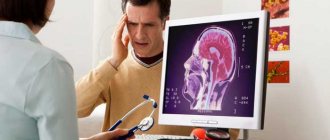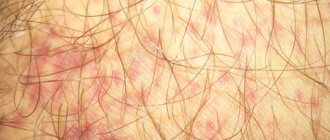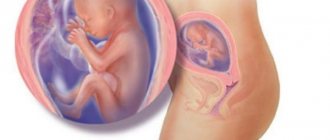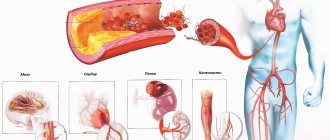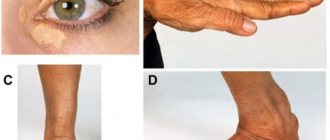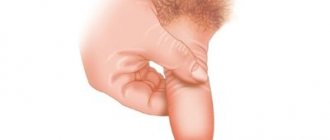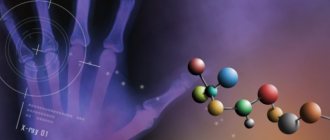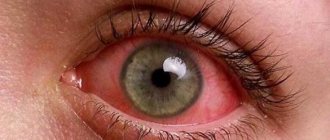Classification of the disease
Depending on the pathogenetic features, the following types of cerebral infarction are distinguished:
- thromboembolic - a heart attack caused by thrombosis of the cerebral arteries, i.e. associated with occlusion of an intracranial vessel by a thrombotic mass or atherosclerotic formation;
- rheological – caused by changes in the blood coagulation system. Blockage of blood vessels by blood clots in this case is due to an increase in viscosity and increased blood clotting due to polycythemia or erythrocytosis;
- lacunar - formed when small intracranial arteries are blocked, usually resulting from arterial hypertension. The development of small foci of infarction is characteristic.
Thromboembolic infarction includes atherothrombotic and cardioembolic. In atherothrombotic infarction, thrombosis or embolism of an arterial vessel arises from foci of atherosclerosis in the intracerebral arteries. Cardioembolic cerebral infarction develops as a result of cardiocerebral embolism in heart disease. In this case, emboli formed in the cavities of the heart are introduced into the arterial system of the brain with the blood flow.
The thromboembolic type also includes hemodynamic cerebral infarction, which occurs when there is a sharp drop in blood pressure against the background of severe stenosis of blood vessels in the brain or neck.
By etiopathogenetic subtypes:
- Atherothrombotic cerebral infarction. The cause of a stroke is a blood clot that forms and blocks a blood vessel. This type of lesion is most often observed after sleep in the morning. The pathological condition appears suddenly, and brain damage can be extensive.
- Cardioembolic. Symptoms of pathology are expressed at the very beginning of its development. The disease can be triggered by an artificial heart valve, atrial fibrillation, emotional or physical stress.
- Lacunar stroke. In this case, small blood vessels going into the deep structures of the brain are susceptible to pathological changes. Over time, cysts form at the site of the lesions. A characteristic sign of pathology is increased pressure. Higher nervous activity is practically not disturbed, there are no general cerebral symptoms. This form of the disease lasts no more than 21 days. Its diagnosis is very difficult, since it is not always detected even with CT scans. This type of pathology is provoked by diabetes mellitus, chronic lung disease, and changes in the blood vessels of the fundus.
- Hemodynamic. This type of cerebral infarction is typical for older people who are diagnosed with atherosclerosis and low blood pressure. The onset of an attack can be gradual or sudden.
- Hemorrhagic. The cause of the development of pathology is a violation of blood flow. Impaired brain function may be accompanied by complete loss of mobility, problems with breathing and swallowing. The risk of death of the patient in this case is very high. A heart attack can happen at any time and anywhere. The rehabilitation period here begins in 2-4 weeks.
According to the vascular basin that is affected:
- Internal carotid artery. The most common disease that affects it is atherosclerosis. However, complete blockage may not cause a cerebral infarction, since replacement blood circulation will occur.
- Anterior cerebral artery. This pathological condition is characterized by paresis of the arms and legs. It is characterized by urinary incontinence, spontaneous flexion or extension reflexes, and mental disorders.
- Middle cerebral artery. This type of disease occurs more often than others. If there is a blockage of the main trunk of the presented vessel, then an extensive infarction occurs.
The figure shows the main arteries of the neck and head
Depending on the affected area:
- Infarction of watershed zones. The lesion is located at the junction of the blood supply territories.
- Lacunar. Blood circulation is impaired in the area of the base of the pons. It is usually multiple, and the diameter of the lesions is 1.5 cm.
- Territorial. In this case, the main arteries of the brain are affected.
Clinical picture
The following symptoms of the disease are observed:
- weakness or complete numbness of the left or right half of the body;
- severe migraine;
- difficulty in orientation in space and time;
- increased drowsiness;
- nausea, gag reflexes, dizziness;
- deterioration in the functioning of receptors in the arms and legs;
- difficulty speaking;
- mild stupor;
- unsteadiness.
During an attack, a person begins to turn pale and blood pressure decreases. If a cerebral infarction occurs in the brainstem itself, a rapid increase in blood pressure is rarely observed. The pulse quickens, but becomes weaker.
With repeated heart attacks, the patient's mental state may be disrupted. Symptoms of asthenia can often be observed even after normalization of the mental state.
What is the difference between ischemic and hemorrhagic stroke
Cerebral infarction occurs in older people through six stages.
| Stages | Deadlines |
| acute | The first 24 hours after a stroke |
| acute | From 1 day to 3 weeks |
| subacute | From 3 weeks to 3 months |
| early recovery | From 3 to 6 months |
| late recovery | From 6 months to 1 year |
| long-term consequences | More than 1 year |
Based on the rate of increase in symptoms, ischemic stroke is divided into four types:
- transient ischemic attack;
- minor stroke;
- progressive ischemic stroke;
- total ischemic stroke.
Based on the cause of occurrence, cerebral infarction is divided into five types:
- atherothrombotic – atherosclerosis of the central artery;
- cardioembolic – embolism of the lumen of blood vessels;
- hemodynamic – hemodynamic disturbance;
- lacunar – diabetes mellitus, hypertension;
- rheological – vascular diseases.
First aid for ischemic stroke is as follows:
- Remove tight items from the patient (belts, corsets, etc.).
- Position the elderly person so that the head and shoulders are higher than the level of the body.
- Measure blood pressure and give medications if readings are above 140/190.
- Make sure that the elderly person does not take any medications.
The main difference between a hemorrhagic stroke and an ischemic stroke is that blood vessels in the brain rupture and cause bleeding, rather than simply becoming blocked. As a result, compression of the brain tissue occurs, followed by damage or necrosis. Blood vessels with aneurysms and weak walls are more susceptible to ruptures and hemorrhages within the cranial cavity.
It is possible to cure cerebral atherosclerosis even in old age. As a rule, the disease is treated conservatively. The patient is prescribed specialized medications, exercise therapy and diet.
If the arteries and vessels become clogged with blood clots, then the patient is indicated for surgical intervention.
Before carrying out therapeutic therapy, a comprehensive differential diagnosis is carried out. The patient must undergo a biochemical blood test and undergo an MRI.
Atherosclerosis is a pathology of the cardiovascular system, in which cholesterol plaques consisting of low-density lipoproteins and esters form in the lumen of arteries and vessels. These neoplasms can affect the arteries and vessels of the lower extremities, the abdominal aorta, the renal arteries, and the vessels of the neck.
There are a number of predisposing factors to the development of the disease. One of these factors is adulthood. Why? The fact is that older people lead a less active lifestyle and eat fatty foods more often.
In addition, with age, vascular walls lose their elasticity, and cells cease to renew themselves regularly. Unfortunately, it is impossible to prevent these processes inherent in aging.
Treatment
Treatment of a heart attack should be started as early as possible, it is highly desirable that this occurs no later than three hours after its manifestation. Timely first aid significantly reduces the risk of complications and subsequent development of the disease, and allows the consequences of cerebral infarction to be minimized.
First aid:
- turn the patient onto his right side and raise his head above body level by 30 degrees;
- unbutton tight clothing;
- measure pressure;
- use a drug that normalizes blood pressure, which the patient usually uses;
- place a tray under the lower jaw if there is vomiting.
However, the very first step should be calling an ambulance.
In the hospital, medications are used to reduce blood clotting and prevent or reduce brain swelling. Therapeutic measures are aimed at stabilizing blood pressure, respiration, pulse rate, restoring and maintaining vital functions.
The immediate cause is acute ischemia, that is, insufficient blood supply to the brain. It can be caused by blockage, spasm, or compression of the arteries supplying blood to the brain.
In the future, surgery may be used to treat a heart attack. With the help of surgery, it is possible to eliminate the factors that led to blockage of blood vessels, which reduces the risk of another heart attack by 70%. Surgical treatment can also be used to increase blood perfusion, reduce intracranial pressure, and maintain cerebral blood flow.
Medical assistance must be provided within three hours after the onset of the attack
Rehabilitation of the patient is of great importance - restoration of speech skills, motor activity, return of muscle tone. Psychological rehabilitation and adaptation of the patient is also important.
Why is a cerebral infarction dangerous? The consequences of a cerebral infarction if timely medical care is not provided can be very serious, including death. This disease ranks second in the structure of mortality after myocardial infarction and belongs to the category of diseases requiring long-term rehabilitation measures.
Symptoms of cerebral infarction
It is generally accepted that extensive myocardial infarction occurs suddenly in a completely healthy person, but this is not entirely true. The disease sometimes develops gradually, and if a person does not receive timely medical assistance, the consequences can be disastrous.
What it is?
Acute insufficiency of blood supply to the heart muscle is called myocardial infarction. This condition is accompanied by thrombosis of the coronary artery and necrosis of the muscle tissue of the organ. To better understand what a heart attack is, you need to understand the characteristics of the disease.
When a small area of the heart suffers from poor blood supply, the heart attack is called small-focal. An extensive heart attack is a complete defeat of the muscle tissue of the organ. This condition often ends in severe complications and even death.
The causes of a major heart attack are:
- Hypertension.
- Angina pectoris.
- Atherosclerosis.
If a person ignores treatment, the disease will provoke a heart attack. The risk group includes people over 60 years of age, as well as those with excess body weight, diabetes, high blood cholesterol and bad habits. Heart attacks are more common among men than among women. Nowadays, cases of heart attacks also occur in people of working age.
Such an insignificant feature as snoring during sleep increases the risk of developing the disease several times. If a person is under constant stress, this can also trigger a heart attack.
Symptoms
Knowledge of the first symptoms of the disease contributes to the timely provision of medical care, minimizing the consequences and preserving human life. A disease such as a massive heart attack is divided into several stages, and at each of them the patient experiences certain symptoms.
- The pre-infarction period lasts from several hours to several weeks. A person feels an exacerbation of angina or an increase in its attacks.
- In the most acute period, myocardial ischemia develops and the formation of an area of tissue death. The duration of the period is a maximum of three hours. During this time, the person feels a burning or pressing pain in the heart and compression in the sternum. Unpleasant sensations may spread to the left arm or shoulder. Inexplicable panic and fear are a characteristic sign of a heart attack. If a person has angina in this way, the pain will subside after taking nitroglycerin. The drug will not help with a heart attack. In addition to pain, profuse sweating, dizziness and often loss of consciousness are noted. If the back wall of the heart muscle is affected, the person will experience some symptoms of poisoning - nausea, vomiting, sharp pain in the stomach. There are cases when an extensive myocardial infarction has atypical symptoms, for example, sudden pain in the right arm. A heart attack occurs painlessly in diabetics, since their nerve endings react slowly to stimuli.
- The acute period lasts up to two weeks. The affected tissue dies and ferments. Tissue necrosis provokes an increase in body temperature, which is why the patient feels a fever. Blood pressure may also increase. Symptoms of heart failure, such as shortness of breath on exertion, are observed. However, after ten days, your health improves, body temperature and pressure gradually return to normal.
- Subacute period - the dead area is scarred, and the signs of a heart attack disappear.
- In the post-infarction period, the heart adapts to the changes that have occurred. After a myocardial infarction, the patient may experience angina attacks, shortness of breath, and heart rhythm disturbances.
Help
If such symptoms are detected, the person immediately calls an ambulance, and it is specified that the patient requires examination by resuscitators or cardiologists. Before the medical team arrives, the patient is reassured, as panic can cause even more harm.
The person takes a comfortable position; it is advisable to place him on a hard horizontal surface. The room where the person having a heart attack is located is thoroughly ventilated. The victim is given a nitroglycerin tablet, and after fifteen minutes, if the pressure readings are not outside the normal range, another one. It is also recommended to slowly chew aspirin, which thins the blood.
If the victim is unconscious, the patient is laid down and his head is thrown back. But if a person shows signs of approaching vomiting, turn their head to the side. In case of cardiac arrest, indirect massage and artificial respiration are performed.
The arriving doctor first of all relieves acute pain; for this purpose, narcotic drugs are used. An electrocardiogram is performed to assess the severity of the condition. If a person enters a medical facility in the first hours after an attack, the consequences can be minimized. The patient will immediately be given a drug that will dissolve the blood clot and normalize blood circulation.
When more than six hours pass from the moment of a heart attack and admission to the hospital, the blood clot thickens and cannot be destroyed with medication. The patient takes medications that prevent the formation of blood clots and prevent ischemia. In the first days after an attack, strict bed rest is indicated. All hygiene procedures are performed by medical staff. However, a person can eat on his own.
If the condition has not worsened, approximately on the third day you can get out of bed and walk around a little. Every day the walking distance gradually increases.
If the patient has suffered a heart attack, he may be indicated for surgical treatment (coronary artery bypass grafting, balloon angioplasty).
After discharge from the hospital, the doctor usually recommends cardiac rehabilitation. The patient receives the necessary procedures in a sanatorium or specialized center. Typically rehabilitation includes:
- lifestyle correction;
- physical therapy;
- psychological support;
- assistance in the selection of medications and vitamin preparations.
For people who have experienced this illness, the doctor prescribes the following medications:
- aspirin (prevents the formation of blood clots);
- diuretics for heart failure;
- nitrates (relieve vasospasm);
- angiotensin-converting enzyme inhibitors, which normalize blood pressure and prevent heart failure;
- statins, which lower blood cholesterol levels;
- beta blockers that improve survival of patients after myocardial infarction.
Consequences
During the first week after an attack, a person may experience the following complications:
- acute heart failure (pulmonary edema);
- heart block;
- recurrent infarction;
- heartbreak;
- inflammation of the outer lining of the heart (pericarditis);
- blood clot formation;
- cerebral circulatory disorders.
The patient may also experience disturbances in the functioning of the digestive system and psyche. The latter happens mainly in older people.
Prevention
Diabetics should regularly monitor their blood sugar levels and follow a therapeutic diet. If a person snores during their sleep, they should be tested for sleep apnea. People who have suffered this heart disease need to do everything to prevent a second heart attack, as it has more severe consequences.
Between the ages of 55 and 75, the human body undergoes all sorts of changes and restructuring. Metabolism slows down, wrinkles form on the skin and chronic diseases become more active. Most older people have problems with blood pressure. It is important to start treatment on time due to the high risk of heart attack and stroke. Pharmaceutical companies offer a wide range of blood pressure medications for older adults.
Many older people suffer from hypertension. Their blood vessels lose elasticity, and their tissues are poorly saturated with oxygen. Heart function worsens and blood cholesterol levels rise. In old age, it is better to systematically monitor your blood pressure and avoid situations that provoke sudden changes in blood pressure.
https://www.youtube.com/watch?v=ntLFPLBSMGg
Signs of hypertension after 55 years are manifested by the following symptoms:
- dizziness;
- headache;
- noise in ears;
- nausea;
- compression in the temples;
- insomnia;
- irritability and anxiety.
The difficulty of treating elderly patients lies in the presence of many diseases that they have developed by this age. For this group of patients, they try to select medications with a minimum number of contraindications, so that they do not complicate the work of already diseased organs.
After 50 years, diseases accumulated over a lifetime begin to appear
The sooner an elderly patient consults a doctor, the greater the chance of normalizing his blood pressure. Lack of treatment can lead to complications of varying severity (renal atherosclerosis, myocardial infarction, internal bleeding, stroke) and even death. The specifics of prescribing drugs depend on the causes and nature of the disease.
Before prescribing treatment, the doctor must fully examine the elderly patient’s body. He needs to know the condition of the patient’s heart and blood vessels, what diseases he already has. Correctly prescribed medications for older people should not complicate other existing diseases.
“Which blood pressure medicine is best for the elderly?” Many old people ask their doctors this question during treatment. The specificity of treating an elderly person is the need to gradually lower his blood pressure. Because of this gradual process, the period of taking high blood pressure medications lasts from weeks to several months. The best blood pressure medicine for older people should bring blood pressure back to normal and cause minimal harm to an already fragile body.
Most likely, it will not be possible to completely cure the disease, however, for older people, a good medicine for blood pressure is something that should improve their quality of life and relieve existing symptoms. For treatment to be effective, the doctor must establish the root cause of high blood pressure and simultaneously treat it.
Modern drugs for lowering blood pressure in older people are prescribed in combination with other drugs
Causes of cerebral infarction in old age
Ischemic stroke occurs due to poor circulation and the formation of blood clots that block blood vessels. The risk of developing the disease increases with age. There are other factors:
- alcohol and smoking abuse;
- diseases of the cardiovascular system;
- overweight and obesity;
- heredity;
- sedentary lifestyle;
- unhealthy diet;
- high blood pressure;
- atherosclerosis;
- high cholesterol;
- atrial fibrillation;
- sickle cell anemia;
- blood clotting disorders;
- Congenital heart defect;
- diabetes;
- taking oral contraceptives.
What it is?
In the international classification of diseases (ICD-10), cerebral infarction is coded I63. At the same time, several subclasses are distinguished based on the causes of this disease:
- thrombosis of precerebral arteries - I63.0;
- embolism of precerebral arteries - I63.1;
- unspecified blockage or stenosis of precerebral arteries - I63.2;
- thrombosis of cerebral arteries - I63.3;
- embolism of cerebral arteries - I63.4;
- unspecified blockage or stenosis of cerebral arteries - I63.5;
- non-pyogenic brain thrombosis - I63.6;
- other cerebral infarction - I63.8;
- unspecified cerebral infarction - I63.9.
In general, pathological processes in the brain are caused by oxygen starvation and lack of nutrients. This occurs due to blockage of blood vessels. The culprits of vascular obstruction may be a detached blood clot or an atherosclerotic plaque formed on the vessel wall, as well as a prolonged spasm. After 5-7 minutes without oxygen, brain tissue begins to soften, and its cellular structure is destroyed. In this case, the process is irreversible, so it is necessary to transport the patient to a medical facility as quickly as possible to provide qualified assistance.
With a cerebral infarction, the prognosis is not the most favorable: in 50% of cases the attack ends in disability, in 15-20% of cases - in death, in 4-5% of cases - in complete or partial recovery (may be complicated by epilepsy).
Diagnostics
The patient is examined using the following methods:
- Cerebrospinal fluid analysis. If there is no blood in the cerebrospinal fluid, then a diagnosis of ischemic stroke can be made.
- Angiography. This research method is used if the patient requires surgical intervention.
The diagnosis must be made as soon as possible. Instrumental diagnostics are used. Computed tomography is an accurate and effective method, since it makes it possible to distinguish hemorrhage from infarction in most cases. Magnetic resonance imaging is also used, but the difference between the methods is that MRI is not used for emergency diagnosis. Duplex scanning and Dopplerography are used to study the condition of blood vessels.
Among laboratory diagnostic methods, an important role is given to the study of cerebrospinal fluid taken using a lumbar puncture. In most patients with intracerebral hemorrhage, blood is found in the cerebrospinal fluid.
Venous thrombosis
Thrombosis of the lateral or sagittal venous sinuses, as well as small cortical veins of the brain, occurs due to the following reasons:
- sepsis (“blood poisoning”)
- intracranial infections (meningitis) due to otitis media, inflammation of the paranasal sinuses, open craniocerebral injuries
- conditions accompanied by increased blood clotting (hypercoagulation), including polycythemia, sickle cell anemia, during pregnancy or taking oral contraceptives
Venous thrombosis leads to increased intracranial pressure, bursting headaches and focal neurological symptoms (focal seizures, paresis, paralysis, etc.). Massive infarctions of the brain parenchyma (ischemic strokes) with secondary edema can be fatal for the patient, including due to the occurrence of severe dislocation syndromes of the midline structures or the brain stem with its pinching under the edge of the tentorium of the cerebellum at the level of the tentorial foramen.
Signs and warning signs of stroke
Typically, ischemic stroke occurs at night. In the morning, the patient feels obvious changes in condition, consciousness and is faced with neurological disorders. Cerebral infarction also occurs during the daytime, but in this case there is a gradual progression of neurological symptoms. Signs of a stroke vary depending on the area affected. The following symptoms of the disease appear:
- vision problems (blindness in one eye or double vision and others);
- diplopia;
- nystagmus;
- numbness or paralysis of the limbs;
- ataxia;
- dizziness;
- Strong headache;
- deterioration of coordination;
- speech disorders (dysarthria, aphasia and others);
- difficulties with understanding someone else's speech;
- paresis;
- difficulty eating and drinking;
- drooping corners of the mouth;
- displacement of the tongue to the paralyzed side;
- hemiparesis;
- infections of the excretory and respiratory systems;
- organ dysfunction;
- cerebral edema (on the third day after the stroke);
- heat;
- increased sensitivity.
Negative consequences
What are the dangers of an attack and the consequences of the disease? Cerebral stroke does not go away without leaving a trace. Untimely medical care or self-medication can cause severe complications or death of the patient. After a heart attack, the patient may experience complications such as:
- paralysis of limbs;
- loss of pain sensitivity;
- lack of coordination;
- blindness;
- epilepsy attacks;
- cognitive disorders.
Most often, people who have suffered a cerebral attack experience problems with speech function. This manifests itself in incoherent and difficult pronunciation. The most dangerous complication is cerebral edema. After an attack, the patient is prescribed bed rest. The consequence of a horizontal position is congestive pneumonia. It develops as a result of poor ventilation of the lungs. This complication appears within a month. Prolonged horizontal position leads to the formation of bedsores. If you don't take action, bedsores turn into a huge wound. An equally dangerous complication is pulmonary embolism and acute heart failure.
Scheme of pulmonary embolism
In severe forms, the patient's death occurs in 15-20% of cases. The health outlook directly depends on the scale of the lesion, the location of the occlusion, the age of the patient, the timeliness of first aid and the recovery period. With a recurrent stroke, the consequences and prospects for a full recovery are more critical. The prognosis for a favorable outcome decreases with each attack.
